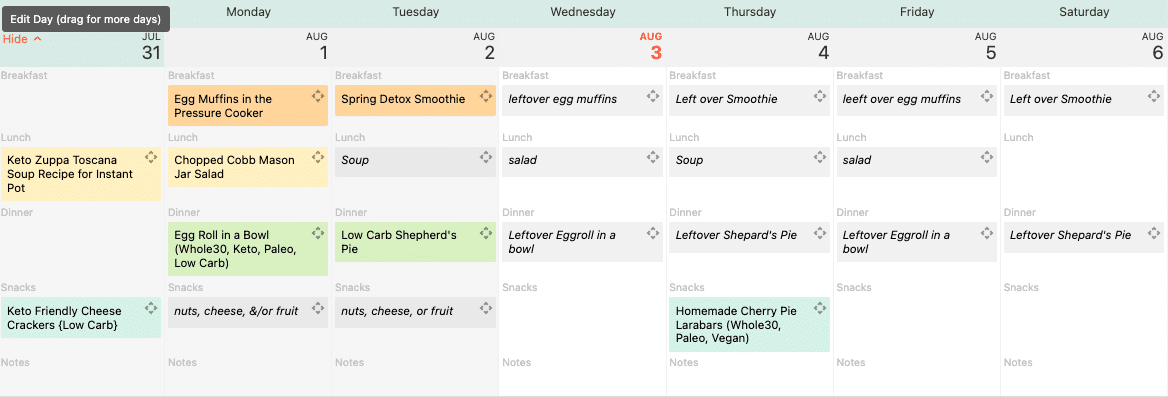How to Meal Plan Series: Small Households
Welcome back to our How To Meal Plan Series! If you’re interested in reading about other “how to plan” methods, check out these posts:
While meal planning is important for one and two-person households, many small families find meal planning leaves them with too much food, they get tired of eating leftovers, or eating out feels like a simpler option. Today, we’re offering two different styles of meal planning for a small household that can help you manage leftovers and maintain flexibility with your schedule.

Our first customer example comes from Laura Rae, who uses meal prepping to help her prepare for a busy schedule and manage leftovers in a one-person household:
As a single female who works full time and wants to eat healthily, efficiently, and economically, the Meal Plan function works great for planning, grocery shopping, and meal prep as often as I can. I devised this method during the lockdown part of the pandemic.
On Sunday or Monday, I prepare; 1-2 breakfast options, 1 soup and 1 salad for lunches that have 2-3 servings each and 2 dinners that have 2-4 servings each. I then portion those out for the week and freeze in portion-sized containers what I do not want this week for sometime later on when I haven’t planned so well.

Laura Rae has a tight system for how she plans. She cooks a set number of meals each week, pre-portions them, and freezes a few servings for later. This meal prep system allows her to have homemade meals on hand during the week without needing to cook every night. She mentions this is also efficient and cost-effective, which is important if you’re a busy working professional. I imagine this allows Laura Rae to focus on her week ahead without thinking too much about food and what she’s going to eat.
Our second approach to feeding a small household comes from Laura B. and focuses on flexibility:
For meal planning for my small, two-person household, I just try to have all pantry essentials and the basics for everything I’d cook. Never be without a shallot, for example! And all the kinds of mustard and vinegar, Asian sauces, etc., I’d use. Then I buy enough ingredients to make a week’s worth of recipes, stretching them out for as long as I want depending on how much takeout or last-minute meal changes we make. I’m all about flexibility. If I have a week’s worth of ingredients, I know we won’t make a last-minute decision to eat something not good.
I don’t do advance meal prep because, as a two-person household, I just don’t have to and I want it to be fresh.
The staples Laura B keeps on hand remind me of the pantry list outlined in Salt, Fat, Acid, Heat by Samin Nosrat. For Laura B the focus is less on efficiency and more on fresh meals. She doesn’t feel the need to meal prep because cooking for two people isn’t as taxing as cooking for a large group. I like that she mentions the flexibility of her meal plan so she and her partner can make a last-minute dinner reservation and easily move their upcoming recipe to a different night of the week.

How Plan to Eat Can Help:
Whether you meal prep and pre-portion your meals, or you cook a new recipe each night, Plan to Eat will help you plan and cook for a smaller household. Here are the top four features to make your meal planning work:
1) Scaling recipes
I cook and meal plan for a two-person household and the problem I encounter the most is forgetting to check the serving sizes of my recipes. If I forget to check the number of servings on a normal weeknight recipe, we end up with a ton of food and leftovers that seem to last forever.
However, if you’re a meal prepper and want to have meals for the whole week, you can scale recipes up to accommodate those leftovers.
Pro tip: If you scale a recipe from the Recipe Book, it will remain scaled for any future times you plan that recipe. If you always want to serve two people, scale from the Recipe Book and you never have to worry about extra food! Alternatively, you can scale a recipe already on the Planner and it will scale for that one instance, which is great to accommodate dinner guests.
2) A flexible meal planner
Drag-and-drop meal planning allows you to reschedule recipes on nights when you make a last-minute change to your plans. You can create a meal plan that’s a “mock-up” for the week and if plans change, you can easily adjust what’s on the calendar with a quick drag and drop.
I plan similarly to Laura B in that I make a meal plan for a week, shop for my ingredients, and then stretch the meal plan as we add other events to our week.
3) The Staples List
You might not run low on staple items quickly with fewer people at home, but being able to add them to your shopping list in bulk is helpful. I use my Staples List to keep track of what I like to have on hand, like Laura B, which are things like olive oil, mustard, bread crumbs, and chicken stock. When I notice I’m running low on those ingredients, I can go to my Staples List and add them to my current grocery list.
4) Add leftovers to the Freezer
I love that when Laura Rae pre-portions her weekly meals, she also adds a few servings to her freezer. This helps with leftover fatigue and helps her have some meals ready to go if she’s ever under the weather or doesn’t have time to cook.
In Plan to Eat, you can add leftovers to the Freezer to keep track of what single-serving frozen meals you have. Once you’ve made a meal that has some leftovers, you can simply go to that recipe on the Planner, select the option to “Prep for Freezer”, add input the number of leftover servings you’re freezing. Since the Prep for Freezer option allows you to add in a custom number of servings, you can add leftovers to the Freezer after you’ve cooked that meal!
If you’d like a video demo of this process, check out our most recent Two-Minute Tuesday video.
Meal planning and cooking for a smaller household doesn’t have a strict rubric to follow. You can plan in the way that works best for you and your family. If you want more tips for how to overcome the challenges of cooking for one, listen to episode #38 of the Plan to Eat Podcast with Erin Lowell of YNAB. You’ll get some one-person planning tips and great budgeting advice too!

